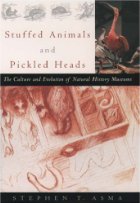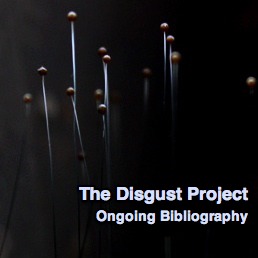
If I have ever read a book that struck such an elegant balance between philosophical inquiry and sordid fascination with the grotesque as Stephen Asma's Stuffed Animals and Pickled Heads, I certainly don't remember it. Asma's exploration of the evolution of modern-day natural history museums, from their primitive ancestors the medieval bestiaries, through Renaissance curiosity cabinets and the private, Enlightenment-era collections of proto-scientists, is perceptive and thought-provoking at every turn. It points out the moral and philosophical implications of curatorial decisions: things that are normally invisible to museum visitors, but which subtly (and sometimes not so subtly) communicate the agendas of their designers. It examines a selection of 18th-, 19th- and 20th-century curated collections, analyzing their presentation and, in the process, taking the reader on a fascinating journey through the history of collecting, classifying, and presenting widely differing versions of Nature in the West. But Asma's book also admits and even honors the darker instincts behind peoples' love of museums: our attraction to the unusual, bizarre, and just plain gross. And I think that's only right. There's no denying the pivotal role played by a prurient fascination with monstrosities, mutations, and myths on the road to science as we know it today. As Asma points out, "Oddities force us to attend. ... Museums figured this out a long time ago."
The jar that first drew my attention was about the size of an industrial stew pot and contained a curdled mass of flesh. This menacing basketball-sized blob was a tumor that John Hunter surgically removed from a man's neck in 1785 (fig. 2.8). Next to the jar was a small card quoting Hunter's notes: "The operation was performed on Monday, October the 24th, 1785; it lasted twenty-five minutes, and the man did not cry out during the whole of the operation." This poor patient had a tumor, roughly the size of his own head, sprouting out of his neck, and Hunter cut it out of him sixty-odd years before anesthesia was discovered - with nothing to numb the pain except some swigs of whiskey. As I pondered many of the pathology jars, I wanted to get on my knees and thank the gods of experimental medicine for letting me be born in the twentieth century.
In the first half of the nineteenth century England's intelligentsia was dominated by the "argument from design." Natural theologians were arguing that the natural world was perfectly adapted - each animal organ and appendage perfectly suited the peculiarities of different habitats and activities. Such perfect design, the argument concluded, proves the existence of a benevolent designer God. One of the overriding impressions that Hunter's pathology collection leaves on the observer, however, is that nature is sloppy. The notion of the perfect adaptation or fit of each animal to its environment and the elegantly coordinated physiological adaptation of each individual to itself (organs arranged and functioning in harmony) is dramatically challenged by Hunter's pathology jars.
As this passage illustrates, Asma moves from grotesque example to illuminating analytical observation, and the whole is delivered in a lively, readable prose. His book is structured, not in strict chronological order, but as a series of related investigative essays covering subjects from the development of taxidermy and embalming, to the history of taxonomy, to the national differences among modern presentations of evolutionary biology. His approach reminded me of an updated take on the 18th-century conversational essay - a form I very much enjoy, and one uniquely suited to Asma's subject matter, given the space he devotes to the Enlightenment-era collections of John Hunter and Georges Cuvier. His approachable prose is a real plus, since the reader is trying to wrap her head around radically different world-views throughout the book. At one point, while discussing a half-digested human stomach, Asma points out that in order to appreciate the specimen from an 18th-century point of view, we must imaginatively think ourselves back to an era when a purely mechanical mode of digestion was a possibility. This is actually quite difficult, since the role of stomach acid is so firmly entrenched in our minds. Similar thought experiments are necessary to grasp many of the pre-Darwinian stops along the track of natural philosophy, but Asma proves a capable conductor, endearingly enthusiastic about the human and scientific oddities he discovers along the way.
In his opening chapter, he observes that
Educational and entertainment institutions meet in the common-ground territory of the spectacular. But some spectacles lead to something cognitive or reflective, and the hope of the educator is to facilitate that trajectory. There is a place in that trajectory for the odd, the wonderful, and the grotesque. But some spectacles, using the same spectacular launching pads of human curiosity, only lead back to themselves. The thrill-ride spectacle can be "managed" in such a way that it leads to more of the same, not contemplation and reflection. The spectacle itself becomes the commodity.
In addition to being an accurate description of his own book, this strikes me as a sane and reasonable take on the "edutainment" debate vis-a-vis museums, which Asma tackles at greater length in his final chapter. While justly concerned about the effect on museums of alliances with corporate sponsors (i.e., how can a museum maintain objectivity in an exhibit about petroleum, if the primary source of funding is an oil company?), he lauds curatorial attempts to lighten the mood of exhibits, to teach with humor and not take themselves and their subject matter in deadly earnest. I think there is a tendency among people who stand up against "edutainment" (understood as entertainment without content), to look down on any exhibit that encourages people to laugh, or connect a scientific concept with some element of popular culture. But, as Asma rightly points out, studies show that laughter improves peoples' willingness and ability to remember information. It therefore seems backward to get sniffy about humorous exhibits, since there's a high likelihood they're doing a better job of teaching than their unfunny analogs, while simultaneously showing museum patrons a good time. Of course entertainment shouldn't be the only experience one finds in a museum, but Asma makes a strong point for it being one effective curatorial tool, and one that, perhaps, ought to be used more often, especially given the modern distrust of authority figures. When a museum can laugh at itself for a moment, he points out, it lets down its guard and becomes more relatable and sympathetic to patrons, and they in turn become more receptive to new ideas.
If used thoughtfully, spectacle and laughter can lead to contemplation; when used exploitatively, they only lead back to themselves. The spectacle in Stuffed Animals and Pickled Heads was uniformly linked to fascinating ideas and information, and I'll be contemplating much of it for a long time to come.
(Stuffed Animals and Pickled Heads: The Culture and Evolution of Natural History Museums was my sixth and 500-century book for the Dewey Decimal Challenge.)


Wow, this book sounds really great! It's such a rich subject, one that can shed light on so many different parts of a culture. And if the writing hearkens back to the 18C conversational essay, so much the better!
Emily, I'd want to blog about this book just for the title alone! However, you've convinced me that it might be interesting as well. Gabba gabba hey!
Thanks, guys! I definitely recommend it. And Dorothy, the style is definitely updated and modern, but has that kind of conversational, seemingly wandering grace that I love about 18th century essayists.
Thank you so much - I hadn't come across this title before, and as a result of your post have solved the annual dilemma of which particular book to present my most academic friend with for his birthday!